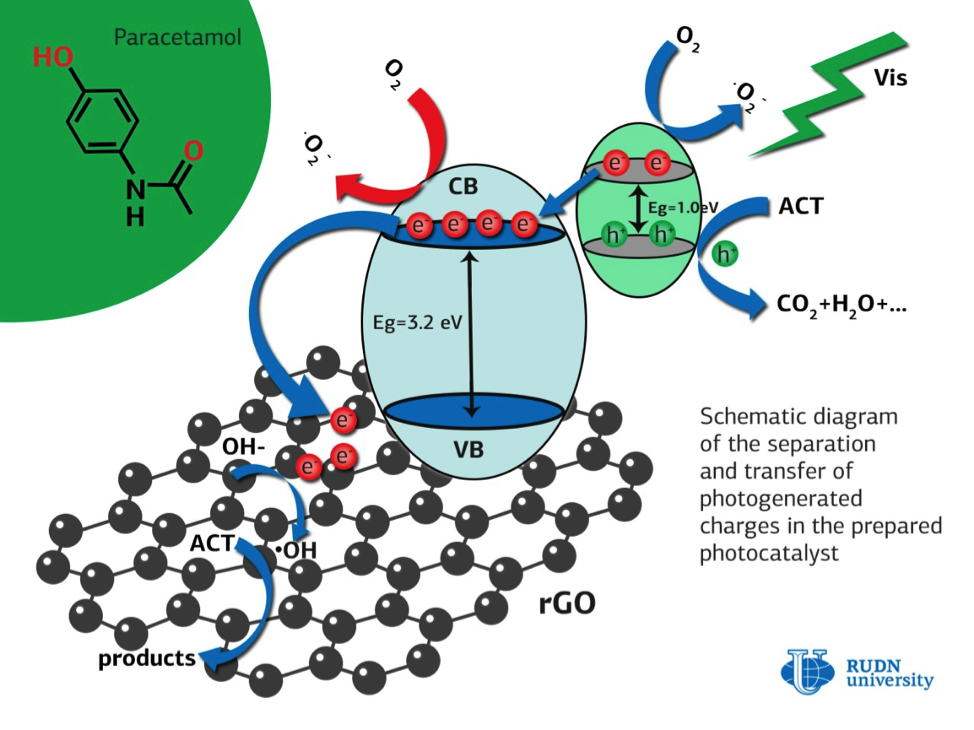RUDN University Chemist Creates a Catalyst to Remove Paracetamol from Wastewater
The widespread use of medicinal and hygiene products has become one of the main factors of wastewater pollution. Imperceptible ‘treatment’ with drugs that can enter the human body from insufficiently treated water, pose a serious threat to both human health and the environment. For wastewater treatment, the method of biodegradation is usually used, when the main work is performed by microorganisms. The second option is adsorption, that is, the absorption of harmful substances by filters-adsorbents. But in this case, it is necessary to solve the issue of recycling filters. Ozone oxidation and some other oxidation methods are also used, but they are expensive and require special equipment.
However, many harmful substances are not biodegradable. One of these substances is acetaminophen, better known to consumers as paracetamol or panadol. This is the most common antipyretic and painkiller in the world, which is sold without a prescription in many countries. About 58-68 percent of the paracetamol in the body is released through the kidneys with urine and enters the city sewer system. In European countries, scientists estimate that the concentration of acetaminophen in wastewater that has already been treated can reach 6 micrograms per liter, and in the United States – 10 micrograms per liter. Therefore, the search for effective and affordable ways to remove this substance from wastewater is an urgent task.
RUDN University chemist Raphael Luque and his colleagues created a series of catalysts for photo-oxidation of acetaminophen in an aqueous medium. The catalyst particles were nanospheres of a composite of zinc oxide and silver sulfide, coated on the outside with a layer of graphene oxide – a layer of carbon one atom thick.
Chemists have found that when the catalyst is irradiated in an aqueous medium with visible light, a short-lived and non-toxic superoxide radical is formed from oxygen dissolved in water. It also oxidizes acetaminophen to water, carbon dioxide and nitrogen, which are harmless to the environment. The sample with a 10% molar silver content had the highest activity.
For comparison, researchers under the same experimental conditions tested the catalytic activity of titanium dioxide and zinc oxide nanospheres coated with graphene oxide. They provided photo-oxidation of acetaminophen by 35 percent for titanium dioxide and 47 percent for zinc oxide in 60 minutes. The new catalysts containing silver sulfide were superior in activity. In 60 minutes, 100 percent of the acetaminophen disappeared from the solution.
The work is published in the Separation and Purification Technology.

The project to develop a cellular model of the placenta became the winner in the Scientific Materials category of the Young Scientists 3.0 competition, organized with the support of the Presidential Grants Foundation and T-Bank.
Ten scientific journals published by RUDN University have been included in the highest level of the state list of scientific publications, the White List.
Forests are not only the lungs of the planet, but also home to millions of species. However, it has remained unclear how underground interactions between trees and fungi affect forest species richness in different climatic conditions. Previous studies have yielded conflicting results: in some regions, the dominance of certain fungi reduced tree diversity, while in others it increased it.
The project to develop a cellular model of the placenta became the winner in the Scientific Materials category of the Young Scientists 3.0 competition, organized with the support of the Presidential Grants Foundation and T-Bank.
Ten scientific journals published by RUDN University have been included in the highest level of the state list of scientific publications, the White List.
Forests are not only the lungs of the planet, but also home to millions of species. However, it has remained unclear how underground interactions between trees and fungi affect forest species richness in different climatic conditions. Previous studies have yielded conflicting results: in some regions, the dominance of certain fungi reduced tree diversity, while in others it increased it.